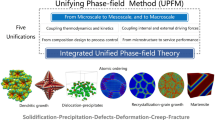Abstract
A number of experimental investigations reported in the open literature have indicated that polyurea possesses a very complex nanometer-scale material microstructure consisting of hydrogen-bonded discrete hard (high glass-transition temperature, T g) domains and a soft (low T g) matrix and that the mechanical properties of this type of elastomer are highly dependent on the details of this microstructure. To help elucidate the internal processes/mechanisms associated with the microstructure evolution and to improve the understanding of microstructure/properties in this material, a multi-length scale approach is developed and utilized in the present work. This approach combines well-established and validated atomic, meso, and continuum length-scale techniques and spans around six orders of magnitude of length (from nanometers to millimeters). While within the atomic-scale approach, the material is modeled as a collection of constituent atom-size particles, within the meso-scale approach this atomistic description of the material is replaced with a collection of coarser particles/beads which account for the collective degrees of freedom of the constituent atoms. One of the main efforts in the present work was the derivation of accurate input parameters for meso-scale simulations from the associated atomic-scale material model and results. The meso-scale analysis provided critical information regarding the material microstructure and its evolution (from an initially fully blended homogeneous state). To obtain quantitative relationships between material microstructure and its mechanical properties, the computed meso-scale material microstructures are combined with a finite element approach. The predictions of the present multi-scale computational approach are found to be in good overall agreement with their experimental counterparts.










Similar content being viewed by others
References
Ryan AJ (1989) Polymer 31:707
Grujicic M, Bell WC, Pandurangan B, He T (2010) J Mater Des. doi:10.1016/j.matdes.2010.05.002
Grujicic M, Pandurangan B, He T, Cheeseman BA, Yen C-F, Randow CL (2010) Mater Sci Eng A 527:7741
Roland CM, Cassini R (2007) Polymer 48:5747
Sun H (1998) J Phys Chem B 102:7338
Sun H, Ren P, Fried JR (1998) Comput Theoret Polym Sci 8(1/2):229
Materials Studio (2009) Visualizer Manual. Accelrys Inc., Princeton, NJ
Materials Studio (2009) Amorphous cell theory manual. Accelrys Inc., Princeton, NJ
Grujicic M, Sun YP, Koudela KL (2007) Appl Surf Sci 253:3009
Materials Studio (2009) Discover theory manual. Accelrys Inc., Princeton, NJ
Theodorou DN, Suter UW (1986) Macromolecules 19:139
Malcolm GN, Rowlinson JS (1957) Trans Faraday Soc 53:921
Materials Studio (2009) Mesodyn theory manual. Accelrys Inc., Princeton, NJ
Hildebrand JH (1919) J Am Chem Soc 41:1067
Materials Studio (2009) Synthia manual. Accelrys Inc., Princeton, NJ
Grujicic M, Zhang Y (1998) Mater Sci Eng A 251:64
Grujicic M, Cao G, Fadel GM (2002) J Mater Des Appl 215:225
ABAQUS/Standard Version 6.8-1 (2008) User Documentation, Dassault Systems
Grujicic M, Bell WC, Pandurangan B, Glomski PS (2010) J Mater Eng. doi:10.1007/s11665-010-9724-z
Grujicic M, Pandurangan B, He T, Hunt J, Tarter J, Dillon G (2010) J Mat Des Appl (submitted)
Runt J (2010) Research in progress, Pennsylvania State University
Yi J, Boyce MC, Lee GF, Balizer E (2006) Polymer 47:319
Bensoussan A, Lions JL, Panicolaou G (1978) Asymptotic analysis for periodic structures. North Holland, Amsterdam
Wilt TE, Arnold SM (1996) Micromechanics Analysis Code (MAC) User Guide: version 2.0., NASA TM-107290
Acknowledgements
The material presented in this paper is based on work supported by the Office of Naval Research (ONR) research contract entitled “Elastomeric Polymer-By-Design to Protect the Warfighter Against Traumatic Brain Injury by Diverting the Blast Induced Shock Waves from the Head”, Contract Number 4036-CU-ONR-1125 as funded through the Pennsylvania State University, the Army Research Office (ARO) research contract entitled “Multi-length Scale Material Model Development for Armor-grade Composites”, Contract Number W911NF-09-1-0513, and the Army Research Laboratory (ARL) research contract entitled “Computational Analysis and Modeling of Various Phenomena Accompanying Detonation Explosives Shallow-Buried in Soil” Contract Number W911NF-06-2-0042. The authors are indebted to Drs. Roshdy Barsoum of ONR and Bruce LaMattina of ARO for their continuing support and interest in the present work. The authors also want to thank professors J. Runt, J. Tarter, G. Settles, G. Dillon, and M. Hargether for stimulating discussions and friendship.
Author information
Authors and Affiliations
Corresponding author
Rights and permissions
About this article
Cite this article
Grujicic, M., Pandurangan, B., King, A.E. et al. Multi-length scale modeling and analysis of microstructure evolution and mechanical properties in polyurea. J Mater Sci 46, 1767–1779 (2011). https://doi.org/10.1007/s10853-010-4998-y
Received:
Accepted:
Published:
Issue Date:
DOI: https://doi.org/10.1007/s10853-010-4998-y




